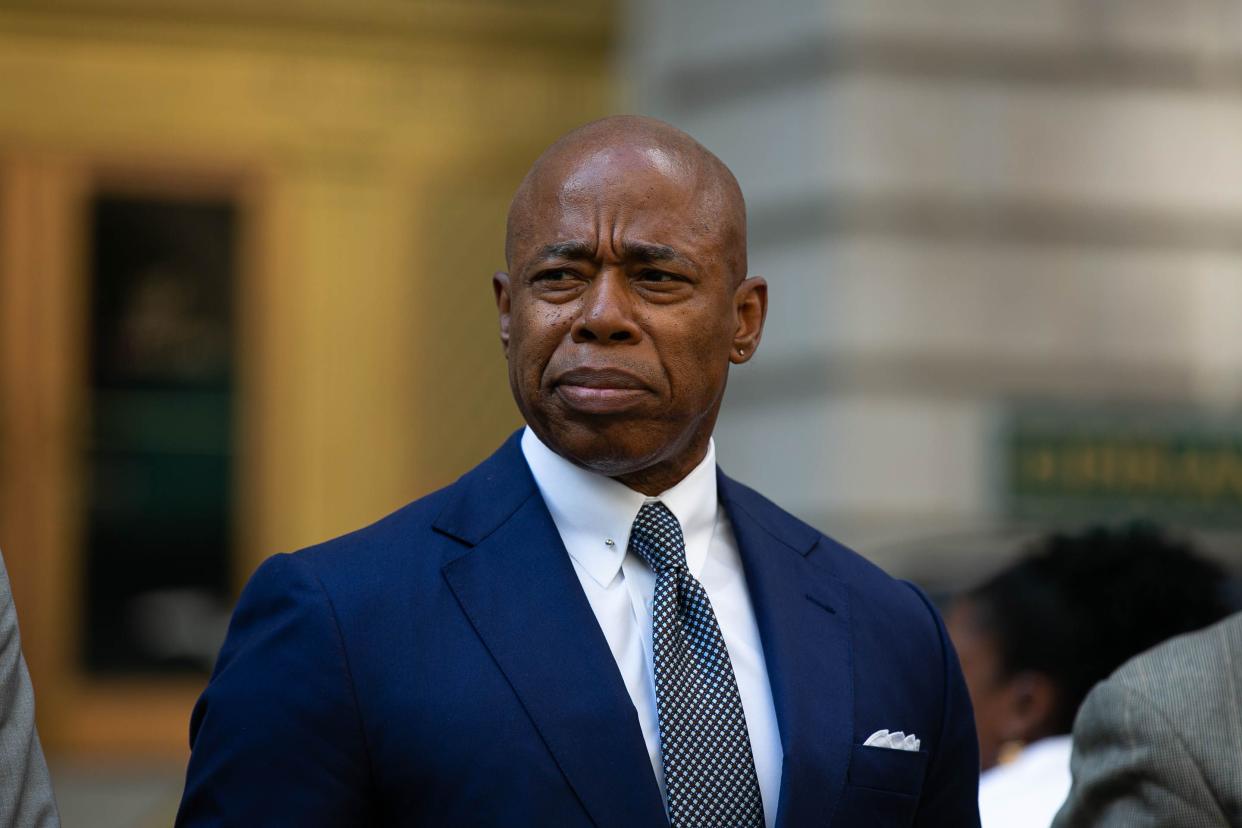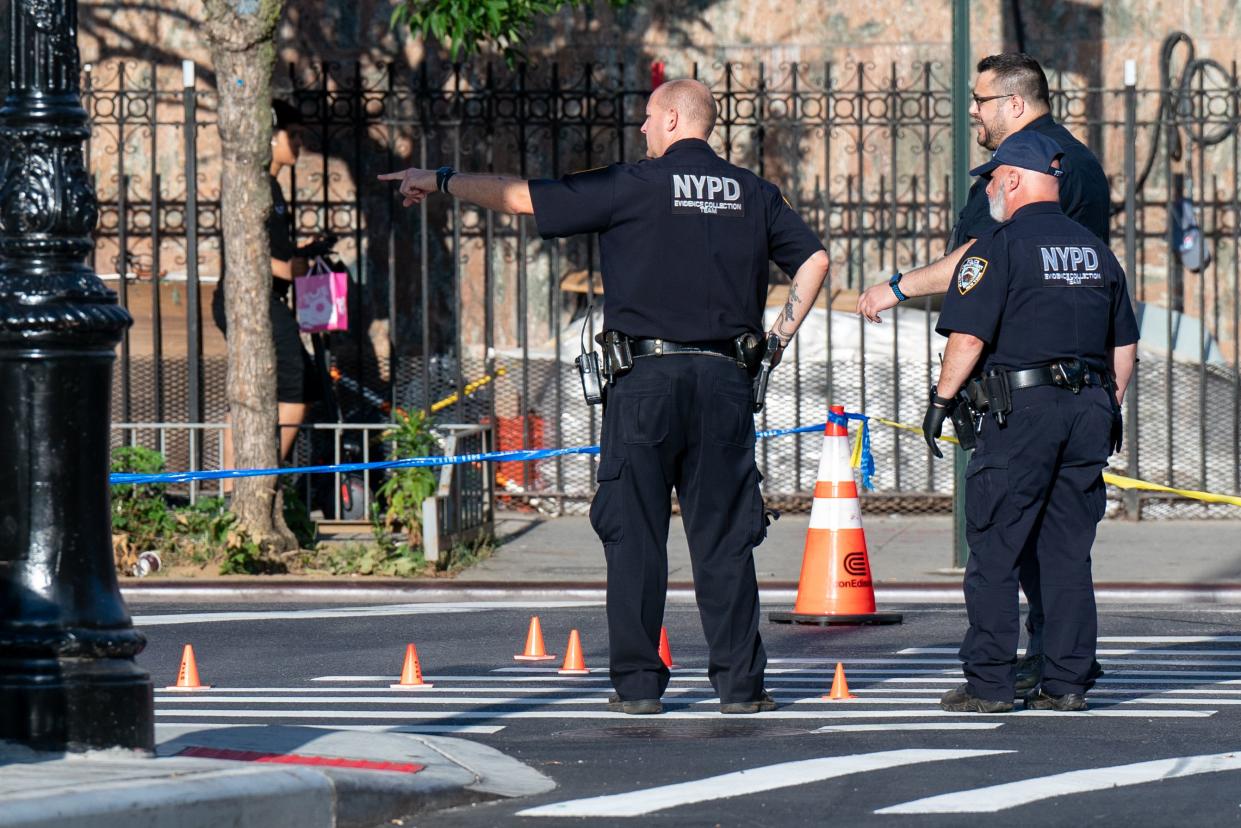Less new affordable housing, more serious crime in NYC: Mayor Adams’ first management report
The pace of affordable housing development in New York City slowed down significantly last fiscal year while major crime rates continued to spike, according to Mayor Adams’ first annual management report.
The 2022 fiscal year report, which was released Friday and covers July 2021 through June of this year, leaves much room for improvement, as the city continues to grapple with cascading economic and social crises that have unfolded during the COVID-19 pandemic.

Mayor Eric Adams is pictured in Bowling Green Park in Manhattan last month. (Shawn Inglima/)
In a statement, Adams acknowledged the many challenges that remain on the horizon for his young administration, but also touted steps in the right direction on some fronts.
“Despite two years of pandemic disruptions and ongoing national economic challenges, this year’s report highlights many areas of success early in our administration, including emergency preparedness, street safety, use of public spaces, quality of life, and youth engagement,” said Adams, who was only in office for the second half of the last fiscal year, succeeding ex-Mayor Bill de Blasio.
“As we continue the reopening process, we will remain laser-focused on improving agency performance across city government, breaking down silos, and ‘getting stuff done’ for all New Yorkers.”
Perhaps the bleakest chapter of the 494-page management report focuses on the state of affordable housing in the Big Apple.
Just 16,042 units of affordable housing were in the pipeline to be built or preserved over the course of the 2022 fiscal year — a 45% drop compared to 29,408 units in the 2021 fiscal year. That fell short of the relatively low 25,000 unit goal set by the city for the 2022 fiscal year.
Of the 16,042 units, only 9,402 were new — a small number for a city of nearly 9 million residents. The remaining units were defined as having their affordability “preserved” due to action by the Department of Housing Preservation and Development.
Link to homelessness
Rachel Fee, executive director of the New York Housing Conference, said the housing figures are alarming and tied them to the city’s increasing homeless population. She also said unresolved staff shortages at the Department of Housing Preservation and Development are exacerbating the issue.
“We have a decline in production, which is a serious cause for concern because we need every unit we can get to address this crisis and house the homeless,” she said. “And the second issue is that they’re not turning around their staff situation quickly enough.”
Earlier this year, Fee’s group and other advocates pressed Adams to make good on his campaign pledge to earmark at least $4 billion in the city government budget for affordable housing development and production. Adams ended up only setting aside $2.5 billion.

A homeless encampment is seen at E. 13th St. between Ave. A and 1st Ave. in Manhattan on March 29. (Luiz C. Ribeiro/)
In rolling out his administration’s housing plan in June, Adams dismissed the idea that the success of housing policies can be measured by the number of new affordable units produced in a given time frame — and opted against setting production benchmarks. Rather, Adams said he’d focus on more nuanced metrics reflecting data on public housing and income levels.
True to that argument, Adams’ management report showed that 44% of the newly-created or preserved units were set aside for New Yorkers in the “extremely and very low-income” bracket.
The report also showed that 5,909 NYCHA public housing units were “preserved or rehabbed” in the 2022 fiscal year thanks to the so-called PACT-RAD funding formula — way up from 1,718 in the 2021 fiscal year.
But in a potentially worrisome sign for NYCHA, only 55% of active capital projects at the Housing Authority were on schedule — down from 73% in the 2021 fiscal year, the report shows. Rent collection at NYCHA was also down from 78.1% in the 2021 fiscal year to 66.8% in 2022 — well below its 97.5% target, spelling potential trouble for the embattled authority’s financial health.
Crime spiking
Since taking office, Adams has dedicated much of his public focus on crimefighting. But the management report provides a grim picture on crime.
In the last fiscal year, the report shows a total of 119,742 “major felony crimes” — murder, manslaughter, rape, robbery, assault and grand larceny. That’s up significantly from the 2021 fiscal year, which saw 95,369 major felony crimes.
Adams’ report suggested his administration is making some headway on addressing the “root causes” of gun violence, though.
Since the release of his “Blueprint to End Gun Violence” in January, the report said NYPD officers confiscated 3,300 guns through the end of June.

Police investigate after a 23 year-old woman was shot on Bedford Ave. at Fulton St. in Brooklyn on Monday, Aug. 8. (Theodore Parisienne/)
The report also touted the fact that the city saw 74,884 participants in its “Summer Youth Employment Program” last summer, nearly meeting its target of 75,000. In addition, Adams expanded the number of slots in the program this summer to 90,000, and the report made the case that such efforts help curb crime in the long run as they are “enhancing opportunities for youth.”
On quality-of-life measures like clean streets — a big focus for Adams — statistics have taken a dip, according to the management report.
The percentage of streets rated “acceptably clean” dropped from 93.7% in fiscal year 2021 to 89.6% in 2022. The total number of “needles removed” more than doubled in one year’s time, jumping from about 32,000 to more than 69,000 in 2022.
Enforcement of sanitation regulations also showed an uptick — one indication that the city is possibly using ticketing to boost revenue in the face of fiscal uncertainty.
In 2021, violations issued by the Department of Sanitation stood at 42,694. That number rose to 46,329 in 2022. Despite the overall enforcement increase within the Sanitation Department, the number of recycling summonses issued has shown a decline in recent years — from more than 84,000 in fiscal year 2018 to about 32,000 in fiscal year 2022.
Areas where Adams’ administration took a victory lap in the report included installing 31.9 miles of protected bike lanes — the most miles installed in a single fiscal year — while fatalities for bicyclists and pedestrians as well as motorists and passengers dropped by 12% and 6%, respectively, compared to the 2021 fiscal year.
There were also some positive signs on the economic front, with unemployment figures in the city ticking down — though they are still elevated as compared to pre-pandemic levels.
Small businesses activity is also improving. The Department of Small Business Services served 41.2% more unique customers and businesses in the 2022 fiscal year as compared to the previous one.
“I know that New York’s best days are ahead,” Adams wrote in a letter appended to the report.
